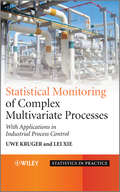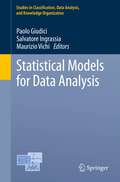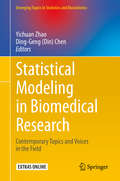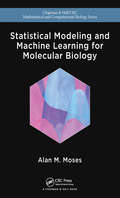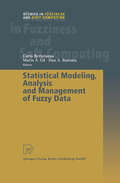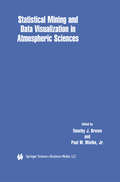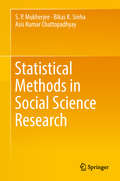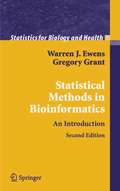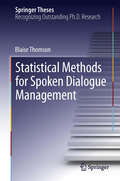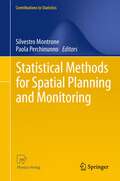- Table View
- List View
Statistical Network Analysis: ICML 2006 Workshop on Statistical Network Analysis, Pittsburgh, PA, USA, June 29, 2006, Revised Selected Papers (Lecture Notes in Computer Science #4503)
by Edoardo M. Airoldi David M. Blei Stephen E. Fienberg Anna Goldenberg Eric P. Xing Alice X. ZhengThis book constitutes the thoroughly refereed post-proceedings of the International Workshop on Statistical Network Analysis: Models, Issues, and New Directions held in Pittsburgh, PA, USA in June 2006 as associated event of the 23rd International Conference on Machine Learning, ICML 2006. It covers probabilistic methods for network analysis, paying special attention to model design and computational issues of learning and inference.
Statistical Monitoring of Complex Multivatiate Processes: With Applications in Industrial Process Control (Statistics in Practice #135)
by Uwe Kruger Lei XieThe development and application of multivariate statistical techniques in process monitoring has gained substantial interest over the past two decades in academia and industry alike. Initially developed for monitoring and fault diagnosis in complex systems, such techniques have been refined and applied in various engineering areas, for example mechanical and manufacturing, chemical, electrical and electronic, and power engineering. The recipe for the tremendous interest in multivariate statistical techniques lies in its simplicity and adaptability for developing monitoring applications. In contrast, competitive model, signal or knowledge based techniques showed their potential only whenever cost-benefit economics have justified the required effort in developing applications. Statistical Monitoring of Complex Multivariate Processes presents recent advances in statistics based process monitoring, explaining how these processes can now be used in areas such as mechanical and manufacturing engineering for example, in addition to the traditional chemical industry. This book: Contains a detailed theoretical background of the component technology. Brings together a large body of work to address the field’s drawbacks, and develops methods for their improvement. Details cross-disciplinary utilization, exemplified by examples in chemical, mechanical and manufacturing engineering. Presents real life industrial applications, outlining deficiencies in the methodology and how to address them. Includes numerous examples, tutorial questions and homework assignments in the form of individual and team-based projects, to enhance the learning experience. Features a supplementary website including Matlab algorithms and data sets. This book provides a timely reference text to the rapidly evolving area of multivariate statistical analysis for academics, advanced level students, and practitioners alike.
Statistical Monitoring of Complex Multivatiate Processes: With Applications in Industrial Process Control (Statistics in Practice)
by Uwe Kruger Lei XieThe development and application of multivariate statistical techniques in process monitoring has gained substantial interest over the past two decades in academia and industry alike. Initially developed for monitoring and fault diagnosis in complex systems, such techniques have been refined and applied in various engineering areas, for example mechanical and manufacturing, chemical, electrical and electronic, and power engineering. The recipe for the tremendous interest in multivariate statistical techniques lies in its simplicity and adaptability for developing monitoring applications. In contrast, competitive model, signal or knowledge based techniques showed their potential only whenever cost-benefit economics have justified the required effort in developing applications. Statistical Monitoring of Complex Multivariate Processes presents recent advances in statistics based process monitoring, explaining how these processes can now be used in areas such as mechanical and manufacturing engineering for example, in addition to the traditional chemical industry. This book: Contains a detailed theoretical background of the component technology. Brings together a large body of work to address the field’s drawbacks, and develops methods for their improvement. Details cross-disciplinary utilization, exemplified by examples in chemical, mechanical and manufacturing engineering. Presents real life industrial applications, outlining deficiencies in the methodology and how to address them. Includes numerous examples, tutorial questions and homework assignments in the form of individual and team-based projects, to enhance the learning experience. Features a supplementary website including Matlab algorithms and data sets. This book provides a timely reference text to the rapidly evolving area of multivariate statistical analysis for academics, advanced level students, and practitioners alike.
Statistical Models of Shape: Optimisation and Evaluation
by Rhodri Davies Carole Twining Chris TaylorThe goal of image interpretation is to convert raw image data into me- ingful information. Images are often interpreted manually. In medicine, for example, a radiologist looks at a medical image, interprets it, and tra- lates the data into a clinically useful form. Manual image interpretation is, however, a time-consuming, error-prone, and subjective process that often requires specialist knowledge. Automated methods that promise fast and - jective image interpretation have therefore stirred up much interest and have become a signi?cant area of research activity. Early work on automated interpretation used low-level operations such as edge detection and region growing to label objects in images. These can p- ducereasonableresultsonsimpleimages,butthepresenceofnoise,occlusion, andstructuralcomplexity oftenleadstoerroneouslabelling. Furthermore,- belling an object is often only the ?rst step of the interpretation process. In order to perform higher-level analysis, a priori information must be incor- rated into the interpretation process. A convenient way of achieving this is to use a ?exible model to encode information such as the expected size, shape, appearance, and position of objects in an image. The use of ?exible models was popularized by the active contour model, or ‘snake’ [98]. A snake deforms so as to match image evidence (e.g., edges) whilst ensuring that it satis?es structural constraints. However, a snake lacks speci?city as it has little knowledge of the domain, limiting its value in image interpretation.
Statistical Models for Data Analysis (Studies in Classification, Data Analysis, and Knowledge Organization)
by Paolo Giudici, Salvatore Ingrassia and Maurizio VichiThe papers in this book cover issues related to the development of novel statistical models for the analysis of data. They offer solutions for relevant problems in statistical data analysis and contain the explicit derivation of the proposed models as well as their implementation. The book assembles the selected and refereed proceedings of the biannual conference of the Italian Classification and Data Analysis Group (CLADAG), a section of the Italian Statistical Society.
Statistical Models and Methods for Data Science (Studies in Classification, Data Analysis, and Knowledge Organization)
by Leonardo Grilli Monia Lupparelli Carla Rampichini Emilia Rocco Maurizio VichiThis book focuses on methods and models in classification and data analysis and presents real-world applications at the interface with data science. Numerous topics are covered, ranging from statistical inference and modelling to clustering and factorial methods, and from directional data analysis to time series analysis and small area estimation. The applications deal with new developments in a variety of fields, including medicine, finance, engineering, marketing, and cyber risk.The contents comprise selected and peer-reviewed contributions presented at the 13th Scientific Meeting of the Classification and Data Analysis Group of the Italian Statistical Society, CLADAG 2021, held (online) in Florence, Italy, on September 9–11, 2021. CLADAG promotes advanced methodological research in multivariate statistics with a special focus on data analysis and classification, and supports the exchange and dissemination of ideas, methodological concepts, numerical methods, algorithms, and computational and applied results at the interface between classification and data science.
Statistical Modelling of Survival Data with Random Effects: H-Likelihood Approach (Statistics for Biology and Health)
by Il Do Ha Jong-Hyeon Jeong Youngjo LeeThis book provides a groundbreaking introduction to the likelihood inference for correlated survival data via the hierarchical (or h-) likelihood in order to obtain the (marginal) likelihood and to address the computational difficulties in inferences and extensions. The approach presented in the book overcomes shortcomings in the traditional likelihood-based methods for clustered survival data such as intractable integration. The text includes technical materials such as derivations and proofs in each chapter, as well as recently developed software programs in R (“frailtyHL”), while the real-world data examples together with an R package, “frailtyHL” in CRAN, provide readers with useful hands-on tools. Reviewing new developments since the introduction of the h-likelihood to survival analysis (methods for interval estimation of the individual frailty and for variable selection of the fixed effects in the general class of frailty models) and guiding future directions, the book is of interest to researchers in medical and genetics fields, graduate students, and PhD (bio) statisticians.
Statistical Modelling and Machine Learning Principles for Bioinformatics Techniques, Tools, and Applications (Algorithms for Intelligent Systems)
by K. G. Srinivasa G. M. Siddesh S. R. ManisekharThis book discusses topics related to bioinformatics, statistics, and machine learning, presenting the latest research in various areas of bioinformatics. It also highlights the role of computing and machine learning in knowledge extraction from biological data, and how this knowledge can be applied in fields such as drug design, health supplements, gene therapy, proteomics and agriculture.
Statistical Modeling in Biomedical Research: Contemporary Topics and Voices in the Field (Emerging Topics in Statistics and Biostatistics)
by Yichuan Zhao Ding-Geng Din ChenThis edited collection discusses the emerging topics in statistical modeling for biomedical research. Leading experts in the frontiers of biostatistics and biomedical research discuss the statistical procedures, useful methods, and their novel applications in biostatistics research. Interdisciplinary in scope, the volume as a whole reflects the latest advances in statistical modeling in biomedical research, identifies impactful new directions, and seeks to drive the field forward. It also fosters the interaction of scholars in the arena, offering great opportunities to stimulate further collaborations. This book will appeal to industry data scientists and statisticians, researchers, and graduate students in biostatistics and biomedical science. It covers topics in:Next generation sequence data analysisDeep learning, precision medicine, and their applicationsLarge scale data analysis and its applicationsBiomedical research and modelingSurvival analysis with complex data structure and its applications.
Statistical Modeling for Computer-Aided Design of MOS VLSI Circuits (The Springer International Series in Engineering and Computer Science #211)
by Christopher Michael Mohammed IsmailAs MOS devices are scaled to meet increasingly demanding circuit specifications, process variations have a greater effect on the reliability of circuit performance. For this reason, statistical techniques are required to design integrated circuits with maximum yield. Statistical Modeling for Computer-Aided Design of MOS VLSI Circuits describes a statistical circuit simulation and optimization environment for VLSI circuit designers. The first step toward accomplishing statistical circuit design and optimization is the development of an accurate CAD tool capable of performing statistical simulation. This tool must be based on a statistical model which comprehends the effect of device and circuit characteristics, such as device size, bias, and circuit layout, which are under the control of the circuit designer on the variability of circuit performance. The distinctive feature of the CAD tool described in this book is its ability to accurately model and simulate the effect in both intra- and inter-die process variability on analog/digital circuits, accounting for the effects of the aforementioned device and circuit characteristics. Statistical Modeling for Computer-Aided Design of MOS VLSI Circuits serves as an excellent reference for those working in the field, and may be used as the text for an advanced course on the subject.
Statistical Modeling and Simulation for Experimental Design and Machine Learning Applications: Selected Contributions from SimStat 2019 and Invited Papers (Contributions to Statistics)
by Jürgen Pilz Viatcheslav B. Melas Arne BathkeThis volume presents a selection of articles on statistical modeling and simulation, with a focus on different aspects of statistical estimation and testing problems, the design of experiments, reliability and queueing theory, inventory analysis, and the interplay between statistical inference, machine learning methods and related applications. The refereed contributions originate from the 10th International Workshop on Simulation and Statistics, SimStat 2019, which was held in Salzburg, Austria, September 2–6, 2019, and were either presented at the conference or developed afterwards, relating closely to the topics of the workshop. The book is intended for statisticians and Ph.D. students who seek current developments and applications in the field.
Statistical Modeling and Machine Learning for Molecular Biology (Chapman & Hall/CRC Computational Biology Series)
by Alan MosesMolecular biologists are performing increasingly large and complicated experiments, but often have little background in data analysis. The book is devoted to teaching the statistical and computational techniques molecular biologists need to analyze their data. It explains the big-picture concepts in data analysis using a wide variety of real-world molecular biological examples such as eQTLs, ortholog identification, motif finding, inference of population structure, protein fold prediction and many more. The book takes a pragmatic approach, focusing on techniques that are based on elegant mathematics yet are the simplest to explain to scientists with little background in computers and statistics.
Statistical Modeling and Computation
by Dirk P. Kroese Joshua C.C. ChanThis textbook on statistical modeling and statistical inference will assist advanced undergraduate and graduate students. Statistical Modeling and Computation provides a unique introduction to modern Statistics from both classical and Bayesian perspectives. It also offers an integrated treatment of Mathematical Statistics and modern statistical computation, emphasizing statistical modeling, computational techniques, and applications. Each of the three parts will cover topics essential to university courses. Part I covers the fundamentals of probability theory. In Part II, the authors introduce a wide variety of classical models that include, among others, linear regression and ANOVA models. In Part III, the authors address the statistical analysis and computation of various advanced models, such as generalized linear, state-space and Gaussian models. Particular attention is paid to fast Monte Carlo techniques for Bayesian inference on these models. Throughout the book the authors include a large number of illustrative examples and solved problems. The book also features a section with solutions, an appendix that serves as a MATLAB primer, and a mathematical supplement.
Statistical Modeling and Analysis for Complex Data Problems (Gerad 25th Anniversary Ser. #Vol. 1)
by Pierre Duchesne Bruno RémillardThis book reviews some of today’s more complex problems, and reflects some of the important research directions in the field. Twenty-nine authors – largely from Montreal’s GERAD Multi-University Research Center and who work in areas of theoretical statistics, applied statistics, probability theory, and stochastic processes – present survey chapters on various theoretical and applied problems of importance and interest to researchers and students across a number of academic domains.
Statistical Modeling, Analysis and Management of Fuzzy Data (Studies in Fuzziness and Soft Computing #87)
by Carlo Bertoluzza Maria A. Gil Dan A. RalescuThe contributions in this book state the complementary rather than competitive relationship between Probability and Fuzzy Set Theory and allow solutions to real life problems with suitable combinations of both theories.
Statistical Mining and Data Visualization in Atmospheric Sciences
by Paul W. Mielke Jr. Timothy J. BrownStatistical Mining and Data Visualization in Atmospheric Sciences brings together in one place important contributions and up-to-date research results in this fast moving area. Statistical Mining and Data Visualization in Atmospheric Sciences serves as an excellent reference, providing insight into some of the most challenging research issues in the field.
Statistical Methods in Video Processing: ECCV 2004 Workshop SMVP 2004, Prague, Czech Republic, May 16, 2004, Revised Selected Papers (Lecture Notes in Computer Science #3247)
by Dorin Comaniciu Kenichi Kanatani Rudolf Mester David SuterThe 2nd International Workshop on Statistical Methods in Video Processing, SMVP 2004, was held in Prague, Czech Republic, as an associated workshop of ECCV 2004, the 8th European Conference on Computer Vision. A total of 30 papers were submitted to the workshop. Of these, 17 papers were accepted for presentation and included in these proceedings, following a double-blind review process. The workshop had 42 registered participants. The focus of the meeting was on recent progress in the application of - vanced statistical methods to solve computer vision tasks. The one-day scienti?c program covered areas of high interest in vision research, such as dense rec- struction of 3D scenes, multibody motion segmentation, 3D shape inference, errors-in-variables estimation, probabilistic tracking, information fusion, optical ?owcomputation,learningfornonstationaryvideodata,noveltydetectionin- namic backgrounds, background modeling, grouping using feature uncertainty, and crowd segmentation from video. We wish to thank the authors of all submitted papers for their interest in the workshop.Wealsowishtothankthemembersofourprogramcommitteeandthe external reviewers for their commitment of time and e?ort in providing valuable recommendations for each submission. We are thankful to Vaclav Hlavac, the General Chair of ECCV 2004, and to Radim Sara, for the local organization of the workshop and registration management. We hope you will ?nd these proceedings both inspiring and of high scienti?c quality.
Statistical Methods in Software Engineering: Reliability and Risk (Springer Series in Statistics)
by Nozer D. Singpurwalla Simon P. WilsonIn establishing a framework for dealing with uncertainties in software engineering, and for using quantitative measures in related decision-making, this text puts into perspective the large body of work having statistical content that is relevant to software engineering. Aimed at computer scientists, software engineers, and reliability analysts who have some exposure to probability and statistics, the content is pitched at a level appropriate for research workers in software reliability, and for graduate level courses in applied statistics computer science, operations research, and software engineering.
Statistical Methods in Social Science Research
by S P Mukherjee Bikas K Sinha Asis Kumar ChattopadhyayThis book presents various recently developed and traditional statistical techniques, which are increasingly being applied in social science research. The social sciences cover diverse phenomena arising in society, the economy and the environment, some of which are too complex to allow concrete statements; some cannot be defined by direct observations or measurements; some are culture- (or region-) specific, while others are generic and common. Statistics, being a scientific method – as distinct from a ‘science’ related to any one type of phenomena – is used to make inductive inferences regarding various phenomena. The book addresses both qualitative and quantitative research (a combination of which is essential in social science research) and offers valuable supplementary reading at an advanced level for researchers.
Statistical Methods in Psychiatry Research and SPSS
by M. Venkataswamy ReddyThis volume, Statistical Methods in Psychiatry Research and SPSS, now going into its second edition, has been helping psychiatrists expand their knowledge of statistical methods and fills the gaps in their applications as well as introduces data analysis software. It addresses the statistical needs of physicians and presents a simplified approach. The book emphasizes the classification of fundamental statistical methods in psychiatry research that are precise and simple. Professionals in the field of mental health and allied subjects without any mathematical background will easily understand all the relevant statistical methods and carry out the analysis and interpret the results in their respective field without consulting any statistician. This new volume has over 100 pages of new material, including several new appendixes. The sequence of the chapters, the sections within the chapters, the subsections within the sections, and the points within the subsections have all been arranged to help professionals in classification refine their knowledge in statistical methods and fills the gaps.
Statistical Methods in Psychiatry Research and SPSS
by M. Venkataswamy ReddyThis volume, Statistical Methods in Psychiatry Research and SPSS, now going into its second edition, has been helping psychiatrists expand their knowledge of statistical methods and fills the gaps in their applications as well as introduces data analysis software. It addresses the statistical needs of physicians and presents a simplified approach. The book emphasizes the classification of fundamental statistical methods in psychiatry research that are precise and simple. Professionals in the field of mental health and allied subjects without any mathematical background will easily understand all the relevant statistical methods and carry out the analysis and interpret the results in their respective field without consulting any statistician. This new volume has over 100 pages of new material, including several new appendixes. The sequence of the chapters, the sections within the chapters, the subsections within the sections, and the points within the subsections have all been arranged to help professionals in classification refine their knowledge in statistical methods and fills the gaps.
Statistical Methods in Counterterrorism: Game Theory, Modeling, Syndromic Surveillance, and Biometric Authentication
by Alyson Wilson Gregory Wilson David H. OlwellWith the realization that many clues and hints preceded the September 11 terrorist attacks, statisticians became an important part of the global war on terror. This book surveys emerging research at the intersection of national security and statistical sciences. In it, a diverse group of talented researchers address such topics as Syndromic Surveillance; Modeling and Simulation; Biometric Authentication; and Game Theory. The book includes general reviews of quantitative approaches to counterterrorism, for decision makers with policy backgrounds, as well as technical treatments of statistical issues that will appeal to quantitative researchers.
Statistical Methods in Bioinformatics: An Introduction (Statistics for Biology and Health)
by Warren J. Ewens Gregory R. GrantAdvances in computers and biotechnology have had a profound impact on biomedical research, and as a result complex data sets can now be generated to address extremely complex biological questions. Correspondingly, advances in the statistical methods necessary to analyze such data are following closely behind the advances in data generation methods. The statistical methods required by bioinformatics present many new and difficult problems for the research community. This book provides an introduction to some of these new methods. The main biological topics treated include sequence analysis, BLAST, microarray analysis, gene finding, and the analysis of evolutionary processes. The main statistical techniques covered include hypothesis testing and estimation, Poisson processes, Markov models and Hidden Markov models, and multiple testing methods. The second edition features new chapters on microarray analysis and on statistical inference, including a discussion of ANOVA, and discussions of the statistical theory of motifs and methods based on the hypergeometric distribution. Much material has been clarified and reorganized. The book is written so as to appeal to biologists and computer scientists who wish to know more about the statistical methods of the field, as well as to trained statisticians who wish to become involved with bioinformatics. The earlier chapters introduce the concepts of probability and statistics at an elementary level, but with an emphasis on material relevant to later chapters and often not covered in standard introductory texts. Later chapters should be immediately accessible to the trained statistician. Sufficient mathematical background consists of introductory courses in calculus and linear algebra. The basic biological concepts that are used are explained, or can be understood from the context, and standard mathematical concepts are summarized in an Appendix. Problems are provided at the end of each chapter allowing the reader to develop aspects of the theory outlined in the main text. Warren J. Ewens holds the Christopher H. Brown Distinguished Professorship at the University of Pennsylvania. He is the author of two books, Population Genetics and Mathematical Population Genetics. He is a senior editor of Annals of Human Genetics and has served on the editorial boards of Theoretical Population Biology, GENETICS, Proceedings of the Royal Society B and SIAM Journal in Mathematical Biology. He is a fellow of the Royal Society and the Australian Academy of Science. Gregory R. Grant is a senior bioinformatics researcher in the University of Pennsylvania Computational Biology and Informatics Laboratory. He obtained his Ph.D. in number theory from the University of Maryland in 1995 and his Masters in Computer Science from the University of Pennsylvania in 1999. Comments on the first edition: "This book would be an ideal text for a postgraduate course…[and] is equally well suited to individual study…. I would recommend the book highly." (Biometrics) "Ewens and Grant have given us a very welcome introduction to what is behind those pretty [graphical user] interfaces." (Naturwissenschaften) "The authors do an excellent job of presenting the essence of the material without getting bogged down in mathematical details." (Journal American Statistical Association) "The authors have restructured classical material to a great extent and the new organization of the different topics is one of the outstanding services of the book." (Metrika)
Statistical Methods for Spoken Dialogue Management (Springer Theses)
by Blaise ThomsonSpeech is the most natural mode of communication and yet attempts to build systems which support robust habitable conversations between a human and a machine have so far had only limited success. A key reason is that current systems treat speech input as equivalent to a keyboard or mouse, and behaviour is controlled by predefined scripts that try to anticipate what the user will say and act accordingly. But speech recognisers make many errors and humans are not predictable; the result is systems which are difficult to design and fragile in use.Statistical methods for spoken dialogue management takes a radically different view. It treats dialogue as the problem of inferring a user's intentions based on what is said. The dialogue is modelled as a probabilistic network and the input speech acts are observations that provide evidence for performing Bayesian inference. The result is a system which is much more robust to speech recognition errors and for which a dialogue strategy can be learned automatically using reinforcement learning. The thesis describes both the architecture, the algorithms needed for fast real-time inference over very large networks, model parameter estimation and policy optimisation. This ground-breaking work will be of interest both to practitioners in spoken dialogue systems and to cognitive scientists interested in models of human behaviour.
Statistical Methods for Spatial Planning and Monitoring (Contributions to Statistics)
by Silvestro Montrone and Paola PerchinunnoThe book aims to investigate methods and techniques for spatial statistical analysis suitable to model spatial information in support of decision systems. Over the last few years there has been a considerable interest in these tools and in the role they can play in spatial planning and environmental modelling.One of the earliest and most famous definition of spatial planning was “a geographical expression to the economic, social, cultural and ecological policies of society”: borrowing from this point of view, this text shows how an interdisciplinary approach is an effective way to an harmonious integration of national policies with regional and local analysis.A wide range of spatial models and techniques is, also, covered: spatial data mining, point processes analysis, nearest neighbor statistics and cluster detection, Fuzzy Regression model and local indicators of spatial association; all of these tools provide the policy-maker with a valuable support to policy development.

